
The United States Merchant Marine Academy is a United States service academy located in Kings Point, New York. It trains officers to serve in United States Merchant Marine, branches of the military, and the transportation industry. Midshipmen are trained in different fields such as marine engineering, navigation, ship's administration, maritime law, personnel management, international law, customs, and many other subjects important to the task of running a large ship.

The United States Coast Guard Auxiliary is the volunteer uniformed auxiliary service of the United States Coast Guard (USCG). Congress established the unit on June 23, 1939, as the United States Coast Guard Reserve. On February 19, 1941, the organization was re-designated as the United States Coast Guard Auxiliary. The Auxiliary exists to support all USCG missions on the water or in the air, except for roles that require "direct" law enforcement or military engagement. As of 2018, there were approximately 24,000 members of the U.S. Coast Guard Auxiliary.

John William Kime was a United States Coast Guard admiral who served as the 19th Commandant of the Coast Guard from 31 May 1990 to 1 June 1994.

Chester R. Bender served as the fourteenth Commandant of the United States Coast Guard from 1970 to 1974. He also served as Superintendent of the United States Coast Guard Academy from 1965 to 1967.

Edwin John Roland, was a United States Coast Guard admiral and served as the twelfth Commandant of the Coast Guard from 1962 to 1966. During his tenure, Roland oversaw the replacement of many World War II era cutters under fleet modernization programs. He also assisted the U.S. Navy with operations in Vietnam by supplying crews and cutters for Operation Market Time. Roland was noted for his support in efforts to bring international safety standards to merchant shipping. Although Roland was already retired when the service was transferred from the Department of Treasury to the newly formed Department of Transportation in 1967, he was largely responsible for the advance planning for the move and the Coast Guard retaining its military responsibilities along with its transportation related functions.

Alfred Carroll Richmond was a United States Coast Guard admiral who served as the 11th Commandant of the United States Coast Guard from 1954 to 1962, the second longest tenure of any U.S. Coast Guard Commandant following Russell R. Waesche who served from 1936 to 1946.
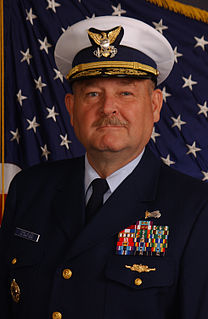
Thad William Allen is a former United States Coast Guard admiral who served as the 23rd Commandant of the Coast Guard. Allen is best known for his widely praised performance directing the federal response to hurricanes Katrina and Rita in the Gulf Coast region from September 2005 to January 2006, and for his role as National Incident Commander of the Unified Command for the Deepwater Horizon oil spill in the Gulf of Mexico in 2010. Robert J. Papp, Jr. succeeded him as Commandant on 25 May 2010, in a change of command ceremony.
Sector Commander is the position title of the commanding officer of a United States Coast Guard Sector, usually of the rank of Captain (O-6). The Sector Commander's second-in-command is the Deputy Sector Commander. Also reporting directly to the Sector Commander are the Command Master Chief (CMC), the Senior Reserve Officer, and the Sector's Auxiliary Coordinator.
A Sector is a shore-based operational unit of the United States Coast Guard. Each Sector is responsible for the execution of all Coast Guard missions within its Area of Responsibility (AOR), with operational support from Coast Guard Cutters and Air Stations. Subordinate commands within a Sector typically include Stations and Aids-to-Navigation (ATON) Teams. Some Sector commands also have subordinate units such as Sector Field Offices and Marine Safety Units that are responsible for mission execution in parts of the Sector's AOR. There are 37 sectors within the Coast Guard.

Jody A. Breckenridge is a former Commander of the U.S. Coast Guard's Pacific Area.

Rear Admiral Larry L. Hereth was the Commander of the Fifth Coast Guard District of the United States Coast Guard. He has also acted as director of port security and Assistant Commandant for Marine Safety, Security and Environmental Protection. He retired in 2007, after 34 years of service.

David Peter Pekoske is an American government official and retired U.S. Coast Guard Vice Admiral who currently serves as the seventh Administrator of the Transportation Security Administration. He also served as acting Deputy Secretary of Homeland Security from April to November 2019. He concluded his 33 years of active military service in 2010 as the 26th Vice Commandant of the Coast Guard.
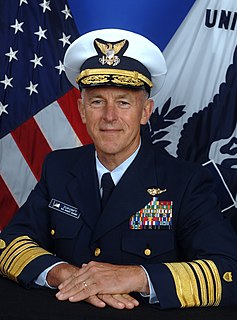
Paul Frederick Zukunft is a retired United States Coast Guard admiral who served as the 25th Commandant of the Coast Guard. He was confirmed by the U.S. Senate as the Commandant, with the rank of Admiral, in May 2014 and relieved Admiral Robert J. Papp Jr. as Commandant on 30 May 2014. Prior to his selection as Commandant, he served as Commander, Coast Guard Pacific Area. In this position, Zukunft was the operational commander for all U.S. Coast Guard missions within the half of the world that ranges from the Rocky Mountains to the waters off the East Coast of Africa. He concurrently served as Commander, Defense Force West and provided U.S. Coast Guard mission support to the U.S. Department of Defense and Combatant Commanders.

Rear Admiral (ret.) Craig E. Bone is a former government executive under President George W. Bush, playing a key role in the forwarding of maritime domain awareness works, inter alia the container security initiative and implementation of the Maritime Transportation Security Act, as part of the wider Global Maritime Intelligence Integration Plan of this administration.

James Clarence Irwin was a vice admiral in the United States Coast Guard who served as Vice Commandant from 1986 to 1988. He had been commander of the 5th Coast Guard District and Chief of the Office of Reserve at Headquarters, Coast Guard. After his term as vice commandant, he served as Commander, Joint Task Force FOUR and Coast Guard Atlantic Area and U.S. Maritime Defense Zone Atlantic.

Clyde Thomas Lusk, Jr. was a vice admiral in the United States Coast Guard who served as Vice Commandant from 1988 to 1990. He had been commander of the Commander of the Eighth Coast Guard District, Chief of Operations of the Eighth Coast Guard District, Commanding Officer of the Merchant Marine Inspection Office, and Chief of the Office of Merchant Marine Safety at Coast Guard Headquarters. He is an alumnus of the United States Coast Guard Academy (1954) and Industrial College of the Armed Forces.
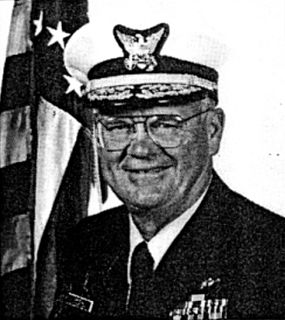
Martin Haynes Daniell, Jr. is a retired vice admiral in the United States Coast Guard who served as Vice Commandant from 1990 to 1992. He is the son of Martin H. and Winifred Daniell. Prior to serving as vice commandant, he was Commander of the Seventh Coast Guard District. During that time he also headed a drug task force in Southern Florida and in the Southeast Region of the National Narcotics Border Interdiction System. He had also been stationed at the Coast Guard headquarters, where he was Chief, Operational Law Enforcement Division; Deputy Chief, Office of Operations; Deputy Chief of Staff of the Coast Guard; and Chief of the Office of Navigation. Daniell was born in Ensenada, Puerto Rico. He is married to Carolyn Betancourt and has three children.
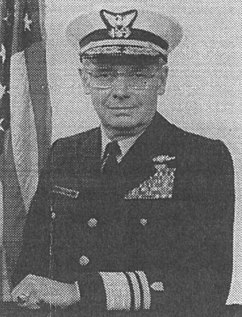
Robert Theodore Nelson is a retired vice admiral in the United States Coast Guard who served as the 18th Vice Commandant from 1992 to 1994. He was previously Chief of Staff of the United States Coast Guard, Commanding Officer at Coast Guard Headquarters, Washington, D.C., Commander of the Second Coast Guard District, and Chief of the Office of Navigation Safety and Waterway Services at Coast Guard Headquarters. He graduated from the United States Coast Guard Academy in 1958. He also is an alumnus of George Washington University.
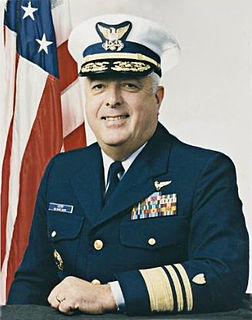
Richard Dennis Herr is a retired vice admiral in the United States Coast Guard who served as the 20th Vice Commandant from 1996 to 1998. He was previously Commander of the Coast Guard Pacific Area and U.S. Maritime Defense Zone Pacific, Resource Director, Comptroller, Coast Guard Chief Financial Officer, Commander of the Eleventh Coast Guard District, Commander of Joint Task Force Five, Commander of Coast Guard Air Station and Commander of Coast Guard Aviation Training Center. He is an alumnus of the United States Coast Guard Academy, Naval Postgraduate School, and National War College.

Peter V. Neffenger was the Administrator of the Transportation Security Administration from July 2015 until his statutorily required resignation on January 20, 2017 upon Donald Trump becoming President. Previously to leading TSA, Neffenger was a Vice Admiral in the United States Coast Guard, serving as Vice Commandant of the United States Coast Guard since May 20, 2014. He previously had served as Deputy Commandant for Operations, Deputy National Incident Commander for the 2010 Deepwater Horizon oil spill, Director of Coast Guard Strategic Management and Doctrine, Commander of the Ninth Coast Guard District, Commander of Coast Guard Sector Los Angeles – Long Beach, Captain of the Port and Federal Maritime Security Coordinator, Budget Officer of the Coast Guard, and Coast Guard Liaison Officer to the Territory of American Samoa. On April 28, 2015, he was nominated by President Barack Obama to be the administrator of the Transportation Security Administration.

















